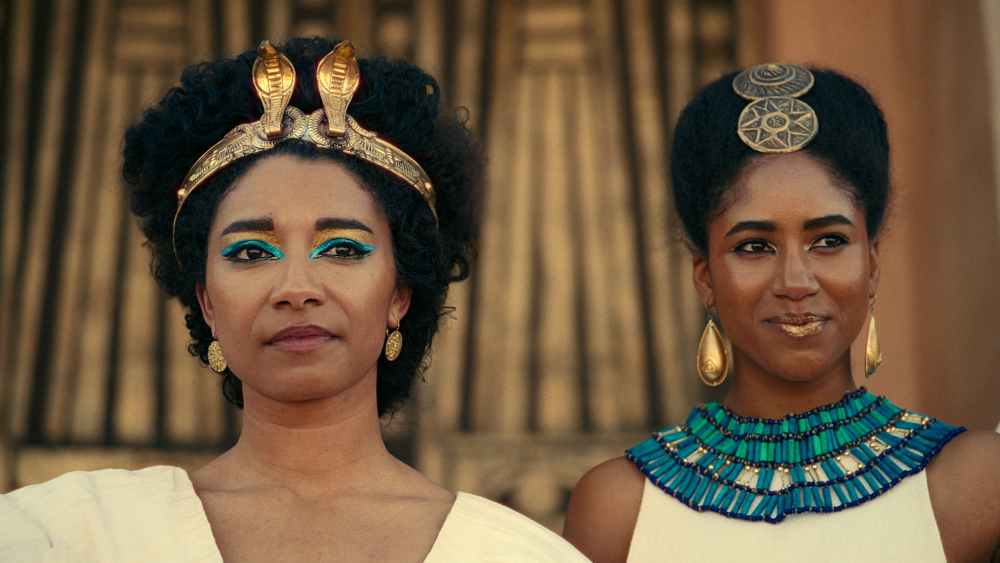As a light-skinned Black woman, I grew up force-feeding my Blackness to anyone bold enough to question my race to my face. To this day, I still get questions like, “What are you mixed with?” Despite this, I admit that it’s hard to care when white-presenting people rage over any challenge to their perceived whiteness. Or when they rage over their heroes’ narratives being challenged publicly. This time, it’s Egyptians’ raging over Netflix’s Queen Cleopatra being portrayed as a woman of color. An obviously brown-skinned woman of color. Netflix’s narrative documentary doesn’t mince ideology. From the very start, Cleopatra’s tanned skin and loose dark curls signal that this iteration of her story will be different. And in case there’s any confusion, the first talking head, Professor Shelley P. Haley, Classics at Hamilton College, steers the ship, “whatever they tell you, Cleopatra was Black”.
The documentary opens on a teenage Cleopatra VII in the Great Library of Alexandria, emphasizing early on that Cleopatra was just as much a scholar as a beauty. She was well-educated, versed in languages, arts and sciences, and at the time, cared little for politics. But that all changes when her Father, Ptolemy XII, suddenly dies, leaving Cleopatra and her younger brother, Ptolemy XIII, co-rulers of Egypt. Cleopatra’s strategic rise to power, love affairs and children with the Romans, Julius Caesar then Mark Antony, her golden, but brief period as Pharaoh of Egypt, and her tragic suicide have been depicted in art, ballets, documentaries, films and literature. Most know how her story began and ended. The real story this time around is the controversy stemming from Cleopatra being played by British actress, Adele James, who is obviously a woman with Black heritage.
Choosing Adele James to portray Cleopatra in what Netflix’s documentary series caused hellfire on social media. Many Egyptians ranted over social media platforms that Cleopatra was Greek and that the documentary falsely identifies her as Black. Many even accused Black Americans, Jada Pinkett-Smith is an executive producer, of commandeering Egyptian history to gain momentum for the “woke movement”. Netflix even had to disable comments under the trailer for the series because of the backlash. And just a few days ago, reports appeared online that Egyptian lawyer Mahmoud al-Semary filed a lawsuit with a public prosecutor to have Netflix banned in Eqypt, claiming a distortion of history.
Netflix isn’t wrong, though, in begging the question, “Was Cleopatra Black?” Cleopatra’s heritage is that of the Ptolemaic dynasty, which came to power in Egypt after the death of Alexander the Great. The Ptolemies ruled Egypt for almost 300 years, Cleopatra VII, being it’s last Pharoah. The Ptolemies were Greek and known for inbreeding. Each Ptolemy that came to power married and fathered children with his sister, usually a Cleopatra, Berenice or Arsinoe. It was long believed that Cleopatra’s father and mother were biological brother and sister, Ptolemy XII and Cleopatra V. But questions about her heritage began to arise when archaeologists from the Austrian Academy of Sciences discovered a tomb believed to be Cleopatra’s sister’s, Princess Arsinoe in 1926. Measurements and computerized reconstruction of a skull taken from the tomb revealed a woman of mixed white European, black African and ancient Egyptian physical characteristics. There is speculation amongst scholars about Cleopatra’s mother and her grandmother’s heritage, as well. Many believe that they may have been produced with an Egyptian concubine. The Netflix documentary academics also note that Cleopatra VII held herself out as racially Egyptian. She emersed herself in Egyptian cultural and religious practices. She hosted many Egyptian-based rituals, most notably the installation of the Buchus Bull, a ritual offering and celebration to the Egyptian god Mantu. She, herself, adopted the title of Pharaoh, a distinctly Egyptian royal title.
Truthfuly, none of us know exactly what Cleopatra looked like, but the Egyptian peoples’ outrage that she is portrayed a Black presenting woman is worth noting. Despite Egypt’s diverse population, that includes people of all different skin tones and ethnicities, colorism persists. And make no mistake, this controversy is steeped with undertones of colorism. Like a large part of the world today, ancient Egyptians associated lighter skin-tones with purity, divinity, and higher social status, while darker skin-tones were associated with labor-intensive outdoor work and lower social status. This is the foundation of colorism throughout much of the world today. Lighter-skinned people are generally portrayed as more desirable, successful and sophisticated, while darker-skinned people face discrimination, bias and limited opportunities. Particularly, those of African decent are more likely to face some level of marginalization, leading to inequalities in education, employment, and access to resources and opportunities.
There is, today, a growing movement towards redefining beauty standards here in the U.S. and other parts of the globe, including Egypt. Fashion designers, models, artists, and influencers are challenging the status quo with campaigns across all types of media featuring diverse skin-tones, body-types, hair textures and the like. Amongst Black presenting individuals, there is a renewed interest in our African heritage, but ignorant parties with insidious motives, haphazardly label any embrace of diversity as “woke,” attempting to mute any progress toward diversity and equality. Don’t get me wrong, I’d be offended if anyone attempted to depict Malcom X as an Irish pacifist that championed integration. Unlike Cleopatra, though, none of us need to speculate about who Malcom X was. Photos of him and his own writings are well-known and not up for debate. Cleopatra’s image is closer to mythology than evidentiary history, and because of that, her depiction will continue to change depending on the vision of artist.








